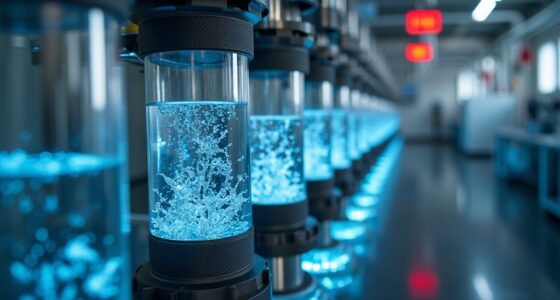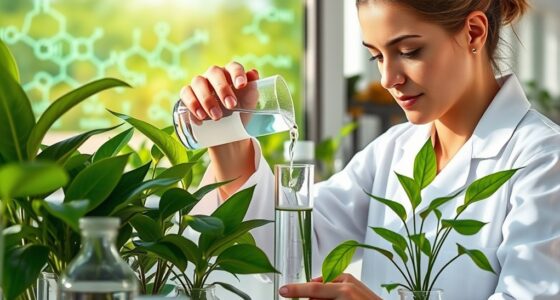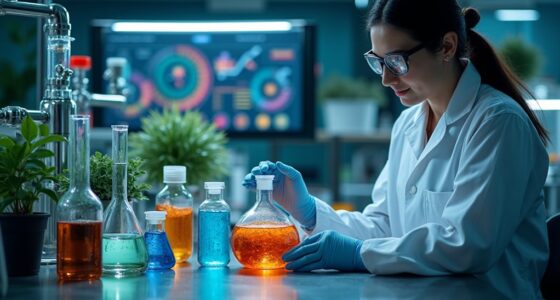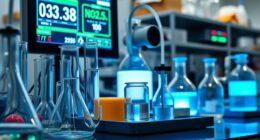Electrochemical nitrogen fixation is paving the way for cleaner, more sustainable fertilizers by converting atmospheric nitrogen directly into ammonia using renewable electricity. This process reduces reliance on energy-intensive traditional methods like the Haber-Bosch process and cuts carbon emissions. Advances in catalyst development are making this technology more efficient and scalable, promising eco-friendly fertilizer production. To discover how ongoing research is transforming agriculture and environmental practices, continue exploring the latest innovations.
Key Takeaways
- Electrochemical nitrogen fixation allows sustainable ammonia production using renewable energy, reducing environmental impact.
- Advances in catalyst development improve efficiency, selectivity, and durability for cleaner fertilizer synthesis.
- Integrating electrochemical processes with renewable sources enables decentralized, low-emission fertilizer manufacturing.
- Improved catalysts suppress side reactions like hydrogen evolution, increasing ammonia yield and process viability.
- Progress in this field promises scalable, eco-friendly fertilizers that support sustainable agriculture and reduce reliance on fossil fuels.

Electrochemical nitrogen fixation offers a promising alternative to traditional methods by enabling the direct conversion of atmospheric nitrogen into ammonia using electrical energy. Unlike the energy-intensive Haber-Bosch process, this innovative approach has the potential to be more sustainable and environmentally friendly.
By harnessing renewable energy sources like solar or wind power, you can considerably reduce carbon emissions associated with fertilizer production. This shift toward greener energy not only decreases the environmental footprint but also aligns with global efforts to combat climate change.
The core challenge lies in improving catalyst development, which is essential for making electrochemical nitrogen fixation efficient and practical. You need catalysts that can operate at low overpotentials, have high selectivity for nitrogen reduction, and withstand the harsh conditions of electrolysis.
Researchers are actively exploring a variety of materials, including transition metals, metal nitrides, and novel nanostructures, to find catalysts that can catalyze the reaction effectively. Developing such catalysts is key because they directly influence the energy efficiency and overall feasibility of the process.
When you improve catalyst performance, you make the process more economical and scalable, bringing it closer to commercial viability. Additionally, advancements in catalyst development can help address issues like competing hydrogen evolution, which often hampers nitrogen reduction efficiency.
By fine-tuning the properties of catalysts, scientists aim to suppress unwanted side reactions and channel electrical energy toward ammonia synthesis. The integration of renewable energy sources with optimized catalysts could revolutionize fertilizer production, making it more decentralized and accessible.
Imagine small-scale, local facilities powered by solar or wind that produce ammonia on-site, reducing transportation costs and emissions. Such innovations could also lessen dependence on fossil fuels, which are heavily tied to the traditional Haber-Bosch method.
Furthermore, progress in understanding the catalyst mechanisms involved in nitrogen fixation is crucial for designing more effective materials and overcoming current limitations. As you follow progress in this field, you’ll notice that collaboration between chemists, engineers, and energy specialists is essential to overcoming current limitations. The development of durable, cost-effective catalysts combined with abundant renewable energy could transform the way we produce nitrogen-based fertilizers.
Advances in catalyst materials and understanding their mechanisms will be pivotal for scaling up this technology to meet global demands. Ultimately, electrochemical nitrogen fixation presents a pathway toward cleaner, more sustainable agriculture—one that relies on cleaner fertilizers made with renewable energy and advanced catalyst technologies. As research continues to accelerate, you can expect to see these breakthroughs move from laboratory experiments to real-world applications, paving the way for a greener future in food production.
Frequently Asked Questions
How Does Electrochemical Nitrogen Fixation Compare Economically to Traditional Methods?
You might wonder how electrochemical nitrogen fixation compares economically to traditional methods. A thorough cost analysis shows that while electrochemical processes currently have higher upfront costs, they could become more competitive with technological advances.
The market potential is promising, especially as demand for sustainable fertilizers grows. As adoption increases, economies of scale may lower expenses, making electrochemical nitrogen fixation a viable, eco-friendly alternative to conventional nitrogen production methods.
What Are the Environmental Impacts of Scaling up This Technology Globally?
Did you know that agriculture accounts for nearly 70% of freshwater withdrawals? Scaling up electrochemical nitrogen fixation could markedly reduce its environmental footprint, leading to healthier ecosystems.
Can Electrochemical Nitrogen Fixation Be Integrated Into Existing Fertilizer Production?
You can achieve sustainable integration of electrochemical nitrogen fixation into existing fertilizer production by focusing on industrial adaptation. This technology can be incorporated with minimal disruption if plants upgrade their infrastructure to support electrochemical processes.
It offers a cleaner alternative, reducing environmental impacts, and aligns with current industry trends toward sustainability. By embracing this shift, you help pave the way for greener fertilizers, ensuring a smoother progression for the industry’s future.
What Are the Current Limitations of the Electrochemical Nitrogen Fixation Process?
You might be surprised to learn that electrochemical nitrogen fixation currently faces significant limitations. About 85% of the process’s potential is hindered by scalability challenges, making large-scale production tough.
Additionally, catalyst efficiency remains relatively low, which affects energy consumption and overall effectiveness. These hurdles mean that, despite promising advances, the process isn’t yet ready to replace traditional methods on a broad scale.
How Long Will It Take for This Technology to Become Commercially Viable?
You wonder how long it’ll take for this technology to become commercially viable. The market readiness depends on overcoming current technological challenges, such as improving efficiency and reducing costs.
While research advances are promising, widespread adoption may still take several years. You should stay informed about ongoing developments, as continued innovation and investment will accelerate this process and bring cleaner fertilizers closer to mainstream use.
Conclusion
By embracing electrochemical nitrogen fixation, you can contribute to cleaner fertilizers, reduce environmental harm, and support sustainable agriculture. You can innovate, you can transform, and you can make a difference. This technology offers a greener alternative, a more efficient process, and a brighter future. So, get involved, stay informed, and be part of the movement toward sustainable food production. Together, you can help create a cleaner, healthier planet for generations to come.









